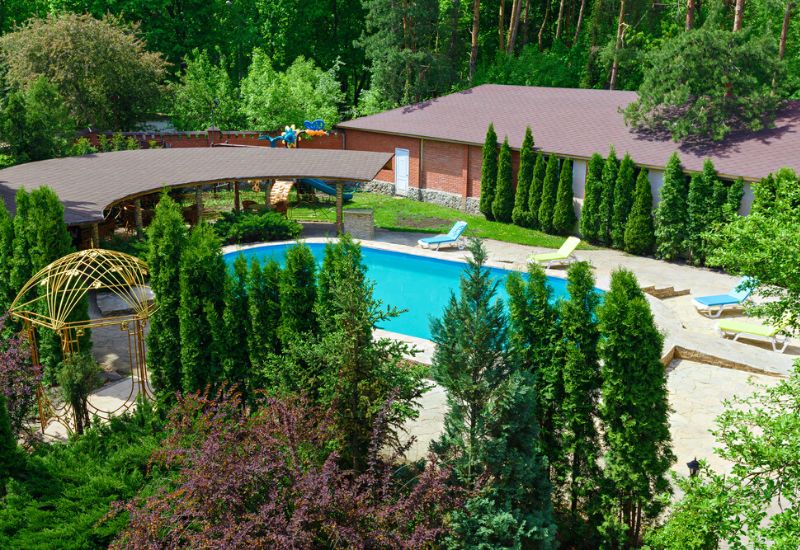
Look at urban and suburban gardens, and you will see tiny plots of land where any passerby can look. But you can solve privacy and space problems in your garden with narrow, columnar, and fastigiate trees.
Tall, skinny trees with columnar, conical, pyramidal habits and even drooping or weeping branches bring verticality, punctuate the different planes of your garden, frame a passage, or mark an entrance.
Grow slender cypresses, junipers, and many evergreens and even deciduous trees when a narrow screen is necessary to block views from neighbors.
Or maybe you need a hedge to protect your garden or a driveway worthy of a manor house? The answer is always the same: go upright rather than sideways with your planting design!
There are columnar varieties of almost every type of ornamental tree; however, they will change their shape to a greater or lesser extent with age. Initially, they grow narrow and columnar, later conical or egg-shaped, and some even develop almost round crowns in old age.
We will see the best tall and slim trees for all these landscaping purposes, so you too can have them growing up into the sky in your green space, with clear descriptions and guidelines to help you along the way.
Landscaping With Tall Skinny Trees
You can mix design and beauty with practical needs if you grow tall and slim trees in your garden. In the end, landscaping is not just a solution to needs, but it’s also a work of art…
Tall and skinny trees are ideal for privacy especially if you have people looking down into your garden. This can happen if there are tall buildings next to your property, but also if you live downhill from a village or a built up area, even from that nosy neighbor we all have…
They are also useful to seal off your yard altogether; in this case you will need many more, and you will need a large space, but this technique has been used for country gardens for centuries.
But how can you do it?
Use Thin Tall Trees to Block Views
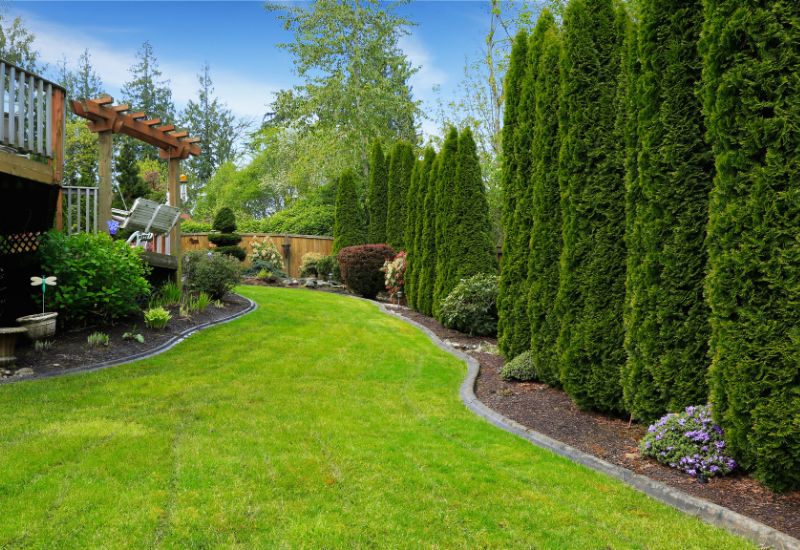
If you want to block prying eyes from windows or higher up places, you only need one or a few tall and slender trees. This will allow you to keep sunlight coming in, while still preserving your privacy.
You don’t need to block all the sky, in fact, just follow me…
Now, on to another landscaping technique.
Use Tall and Narrow Trees for Hedges
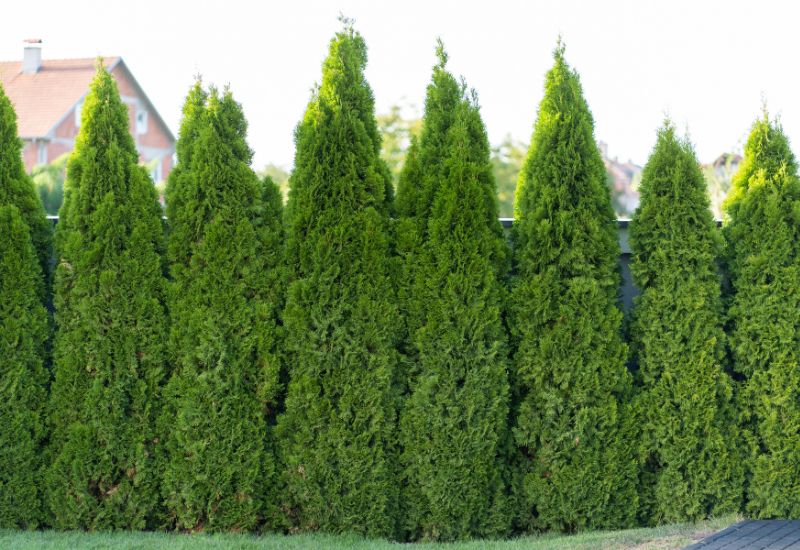
High hedges require two things: tall plants and a large garden. Some trees fall perfectly into this category.
For example, cypresses are used all over the Mediterranean to grow “green walls” that not only block views, but they literally discourage intruders.
In this case, you will need to plant your chosen trees very close, so that they touch or almost touch. The flip side is that you need a lot of space for this solution.
A tall hedge will cast long shadows into your garden, unless you have it on the north side of your garden. If you only have a small yard, opt for a shorter hedge instead.
But there are other reasons why you should choose columnar, conical and pyramidal trees.
Skinny Trees Give You a Vertical Dimension
Tall and skinny trees produce vertical lines that point to the sky. This is very useful in garden designs; they can distract viewers from unsightly points to start with, directing them up to the clouds.
But it is also useful on the whole for shape and structure.
A pyramidal or conical tree will give your yard a clear architectural statement, and if you mix them with trees or shrubs with other habits, you will get that variation and variety that all beautiful species need if they don’t want to become monotonous.
columnar on the Sides of Paths and Drives
There is not a single stately park or garden in the West without tall and skinny trees coasting long drives.
All important estates in Europe have the main entrance dotted with cypresses or aspens, for example.
True, the former have a more “noble” look, the latter are more typical of country farms… Still the idea is the same.
You can reproduce this look in your property as well. Of course, you will need a large space, but even if you only have an average suburban garden, you can still have the same concept on a reduced size…
Slender Trees for Poolsides
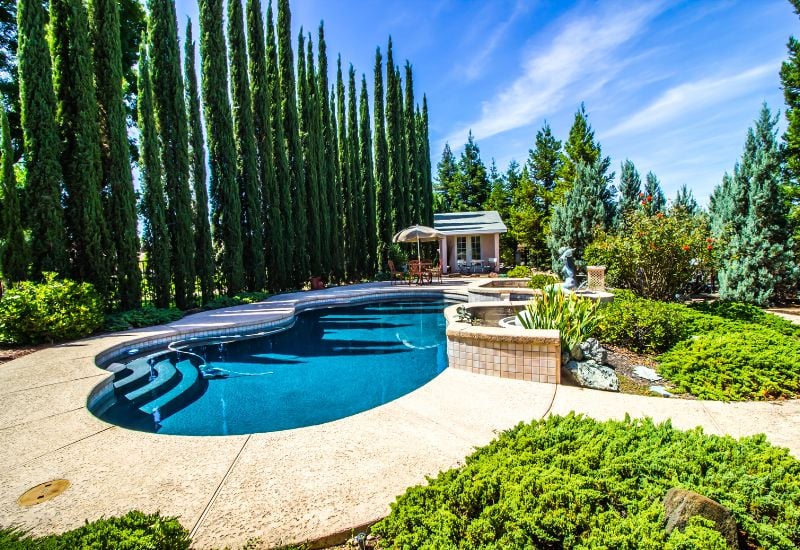
You will also find tall and skinny trees next to pools, especially evergreen varieties. This is a design choice but also a practical one.
The reason is that if you want some green next to your swimming pool, you don’t want it inside it…
Large trees risk dropping leaves into the water, and they also cast large shadows, which is not what we want when we are bathing…
Palms are Tall and Skinny, but Not So Good for Privacy
Talking of poolside, the first tall and skinny trees that come to mind are palms. And in fact they look great in this situation. But are they good for privacy?
Well, not really. They have a very long and often slender trunk, but this is not enough to block views. The crown, where the fronds are, keeps changing height, as it shifts up and up when the plant grows.
This means that it will only block views for a few years, and then, it will lift like a theatre curtain and your neighbors will be able to look into your garden again…
And now, let’s get into the main part of this article…
10 Tall, Skinny Trees for Small garden And landscape
Naturally characterized by their dense growth, narrow and upright habit, there are many columnar trees to match every garden style. Here are ten of our favorite tall skinny trees ideal for small gardens and landscapes.
1: Italian Cypress (Cupressus sempervirens)
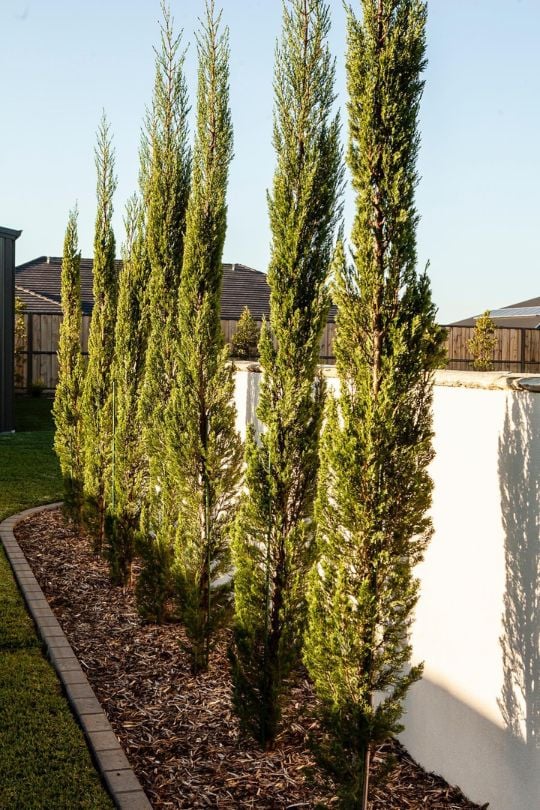
Italian cypress is a classic tall and skinny tree of the Mediterranean, ideal to protect your privacy, reaching up to 70 feet in height (21 meters).
You will see them dotted on the horizon like green columns, or long flames – a spectacular sight! And you can enjoy this beauty while blocking views into your garden. In fact, the foliage is so thick that no one can see through, and another plus side is that it is evergreen, and fragrant!
It is a very strong and resilient plant as well, basically disease free and low maintenance, if grown in rows, it will build a natural wall that reaches into the sky, loved by birds, but literally impenetrable.
If you live in a hot and dry climate region, like California or other southern states, Italian cypresses are the optimal solution.
They will tolerate dry spells, and they can give you a majestic and evocative effect, while keeping unwanted eyes away… But they are also relatively cold hardy, so, check your USDA zone and see if you can grow them.
2: ‘Sky Pencil’ Japanese Holly (Ilex crenata ‘Sky Pencil’)
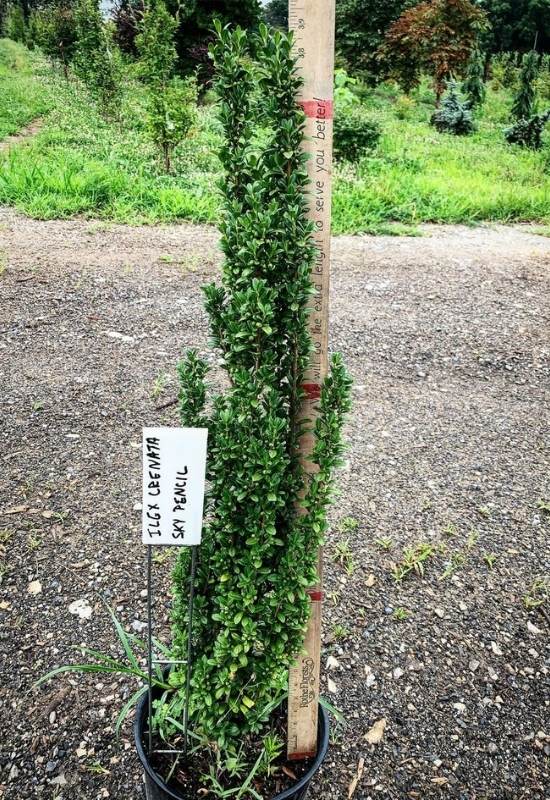
‘Sky Pencil’ is the perfect name for this Japanese holly cultivar that can grow to 10 feet (3.0) meters with a columnar and narrow habit, giving you privacy from curious eyes.
The mid to dark green convex foliage will start low down on the trunk, almost at ground level; it will then spread slightly carried by upward growing branches.
The mid green leaves are fairly thick and they produce lovely light games all year round, as this is an evergreen plant too.
This holly is elegant and with a light look. And you will also get lots of tiny white flowers in spring, followed by decorative black fruits in summer and fall!
‘Sky Pencil’ is an ideal skinny tree for smaller spaces or solutions; you can have a permanent hedge above head level if you grow a few packed together on the borders of your property, or you can get a view block by placing it closer to where you want to have some privacy, like a bench, or an entertainment space in your garden.
3: Swedish Aspen (Populus tremula ‘Erecta’)
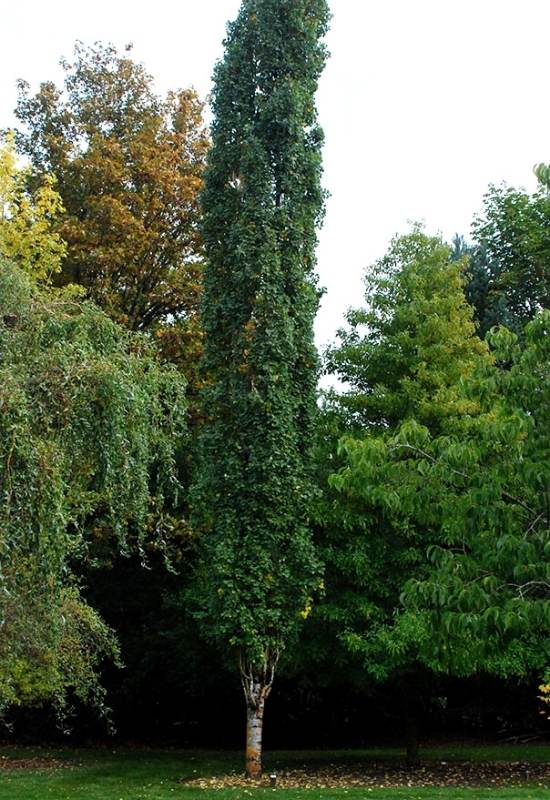
Swedish aspen will protect your privacy with its thick foliage and thick upright branches that will touch 40 feet in height (12 meters) on a very straight and long trunk.
The nearly round, pointed leaves, almost cordate in shape will form a thick plume of green freshness, and they are at their best when they shake in the wind. In fact, this columnar beauty is perfect for wind breaks as well.
It will turn yellow and orange in fall, for a final burst of colors before winter. It is a deciduous species, so it will not give you the same protection in winter, still, the thick mesh of branches will discourage curious looks even when it’s cold and snowy. It is in fact extremely cold hardy!
Swedish aspen is perfect for gardens with a naturalistic design and a temperate inspiration; it gives you that sense of “gentle countryside”.
It is also ideal for farms, ranches and large fields, but you can adapt it to urban settings, also because it is quite good at cleaning the air from pollution. This way you also get a health benefit on top of privacy.
4: European Silver Fir (Abies alba)
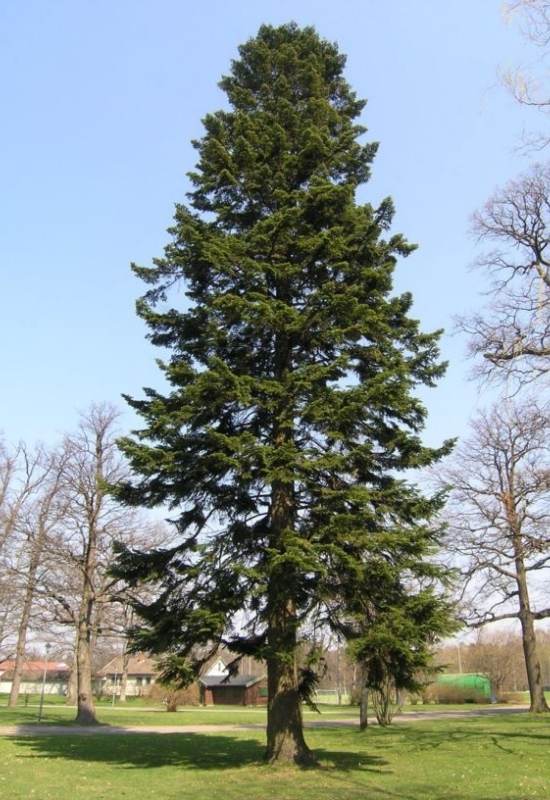
European silver fir is a fastigiate evergreen conifer with perfect conical shape, narrow and tall, up to 80 feet (24 meters). The branches start off very low on the straight and upright trunk, and they taper as you go up towards the pointed tip. The branches point down elegantly, and they are thickly covered in short emerald green needles, unlike other firs that have thin foliage.
This is of course an evergreen conifer, which means it will stay beautiful all year round and, of course, also decorative cones. And once you have planted it, it will stay in your garden long after you are gone: in fact, these trees live up to 600 years! It is perfect for a mountain look, and it can double as an ideal Christmas tree!
European silver fir is good to block views from even very tall buildings, but it is less suitable for tall hedges because of its shape; you would still get a towering “wall of green” but with gaps at the top.
5: American Arborvitae (Thuja occidentalis)
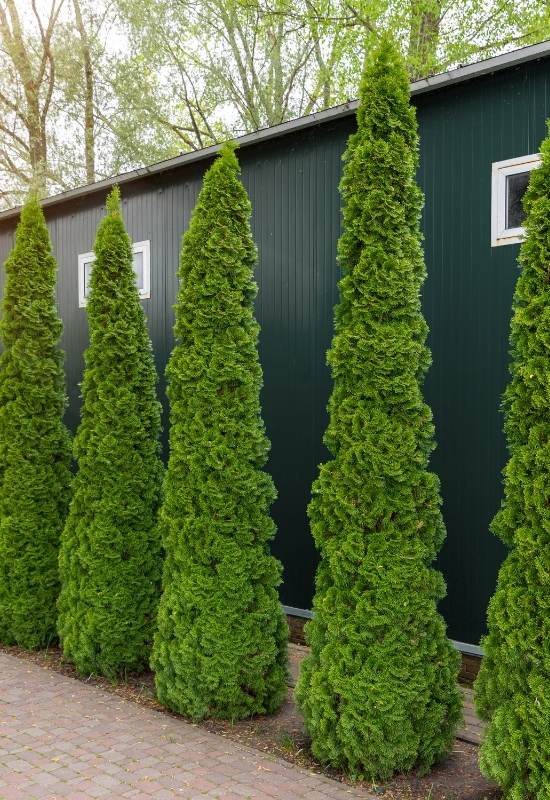
American arborvitae (“tree of life”) is a perfect columnar evergreen tree for elegant gardens and privacy. It grows for up to 12 meters in dense cylinders with a tapering tip.
The leaves are scale like, rich middle to dark green and they form a cushion of soft and intricate texture from the feet of the tree to the very top. They are also fragrant and in fall and winter they may turn yellow green or even brown green, especially if the plant is exposed to wind and Sun.
What is more, even if the trunk is almost fully covered, it is in itself a real beauty! It exfoliates with maturity and it reveals a stunning reddish bark! And you will have this color display for a long time on your property, because American arborvitae can live up to a whopping 1,500 years!
This lesser known tree is perfect if you want to solve the practical problem of privacy and also add a sculptural and structural element to your garden design, as well as lots of colors all year round. It is equally suitable as a view blocker and for tall hedges.
6: Norway Spruce (Picea abies ‘Cupressina’)
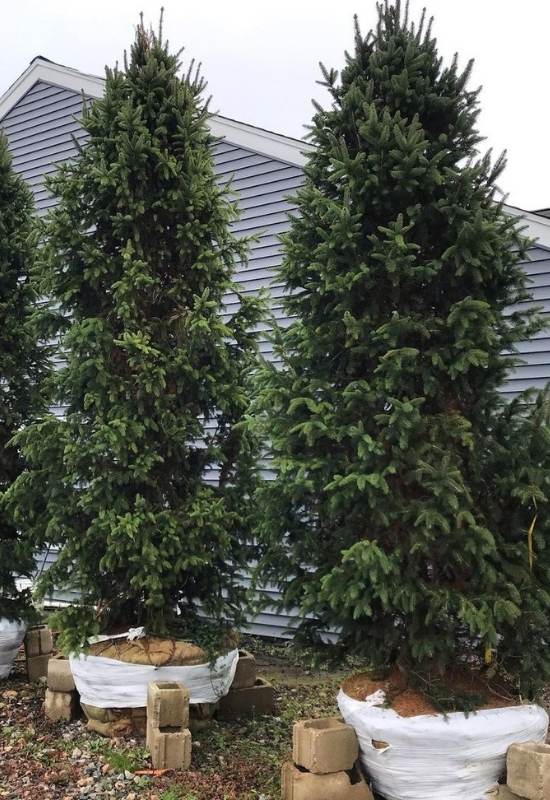
The evergreen conifer Norway spruce has a long and narrow columnar to conical habit and it can reach 7.5 feet in height in a matter of a few years. In fact, Norway spruce it is a very fast growing skinny tree, adding up to 12 inches (30 cm) to its height every year. The foliage is very dense, made of thick green needles on regularly arranged branches.
However, as the cold season approaches, you will notice that the needles of this hardy spruce take on beautiful shades of blue.
This way, you can have a decorative tree with structural qualities as well as a lovely palette, in two versions: a summer one and a winter one!
Norway spruce grows fast but then it stops; it will never grow too tall. For this reason, it is ideal if you want to have a fast and permanent solution to your privacy problems; at the same time it is perfectly suited to small, urban and suburban gardens, where space is at a premium and extremely tall trees can cause arguments with neighbors.
7: Chinese Juniper (Juniperus chinensis)
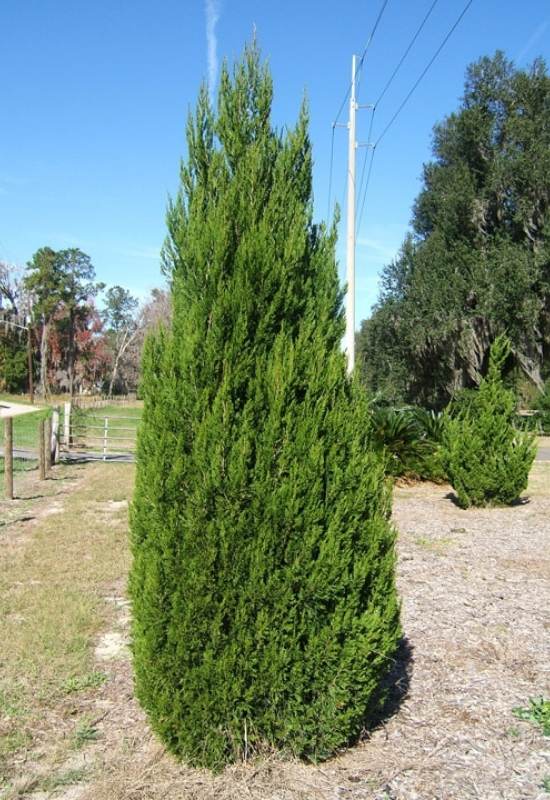
Chinese juniper is a beautiful, tall and narrow pyramidal to columnar evergreen conifer that can reach 20 feet high (6.0 meters), more than enough to protect your family’s privacy in most urban and suburban gardens.
It has a Mediterranean look, but you can grow it in most areas of the USA, Europe and even in some parts Canada, as it is cold hardy.
It has beautiful mid to emerald green foliage, scale shaped and quite thick on the many branches that form a dense crown that starts very low on the trunk and ends in an elegant plume like tip.
It is also a very tough plant, low maintenance and disease free. It will also produce beautiful dark blue berries to give your garden a nice twist.
Chinese juniper is a safe choice for privacy in small gardens, but you can grow it in larger spaces as well. It is also fast growing, so you can have quick results, whether you use it to block views or for green barriers to intruding eyes. It is also ideal for coastal gardens.
8: ‘Amanogawa’ Japanese Flowering Cherry (Prunus ‘Amanogawa’)
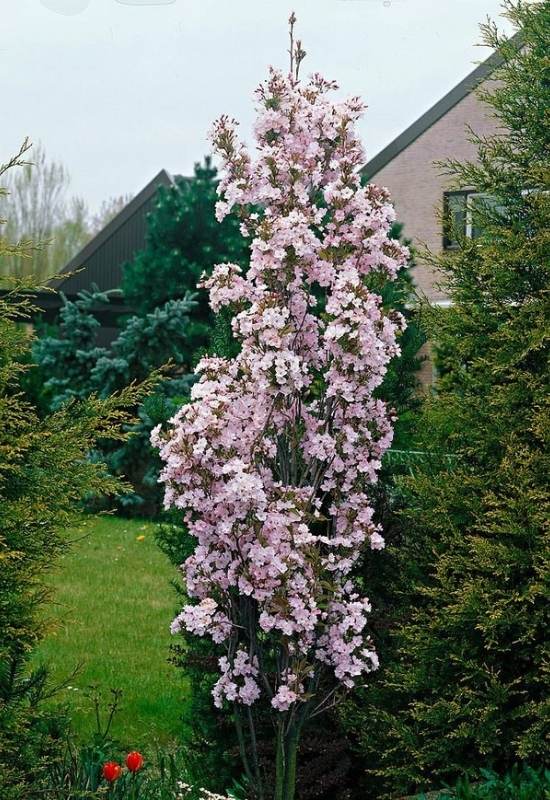
If you also want amazing blooms in your garden as well as privacy with a tall and slim tree, then ‘Amanogawa’ Japanese flowering cherry is is ideal for tight spaces. Growing up to 25 feet in height (7.5 meters) and filling with a massive fragrant blossom of semi double white and rose flowers at the ends of it’s very vertical branches.
After flowering, this deciduous tree will then fill with copper leaves, then bright green as they mature.
You do get cherries too, of course. It has won the Award of Garden Merit by the Royal Horticultural Society and it only has one drawback: the leaves will fall in winter.
For this reason, ‘Amanogawa’ Chinese flowering cherry may suit better a summer house, in the middle of this lawn or standing out in front of a hedge.
Then again, if you don’t spend much time outdoors in winter, it will protect your garden’s privacy when you need it and welcome you back every spring with a rare spectacle!
9: Japanese White Birch (Betula platyphilla)
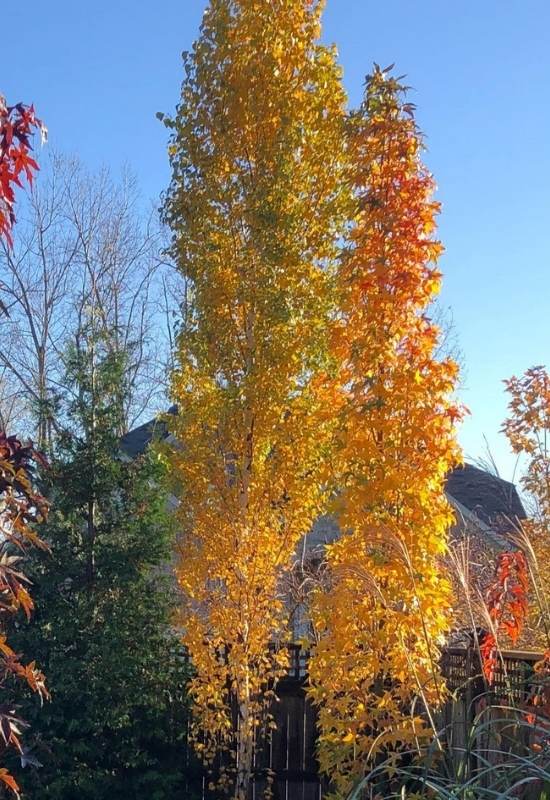
Japanese white birch is a is a medium to large sized tree with a pyramidal habit and a very light, elegant and airy appearance.
It has straight, tall trunks with lovely smooth white peeling bark. During the warm season, the many emerald green leaves form a lovely canopy that allows some sunlight through, they have an almost triangular shape and they will turn into beautiful shades of yellow, orange and even red as fall approaches.
Spring will see them fill with colorful yellow brown flowers on male specimens and green flowers on female ones. And they too are not the end of the elegant display of this deciduous tree… Blooms will turn into lovely winged seeds, playful favorites of children and young adolescents.
I would choose Japanese white birch to block views from lawns and living spaces within gardens while keeping some sunlight, and avoiding a sense of “closed space”. At the same time you can enjoy the continuously changing elegant displays of this amazing tall and skinny tree.
It is also very suitable for northern, Canada inspired gardens… Finally, they are suitable for dense planting, which is ideal to create tall and wide barriers to viewers.
10: ‘Twombly’s Red Sentinel’ Japanese Maple (Acer palmatum ‘Twombly’s Red Sentinel’)
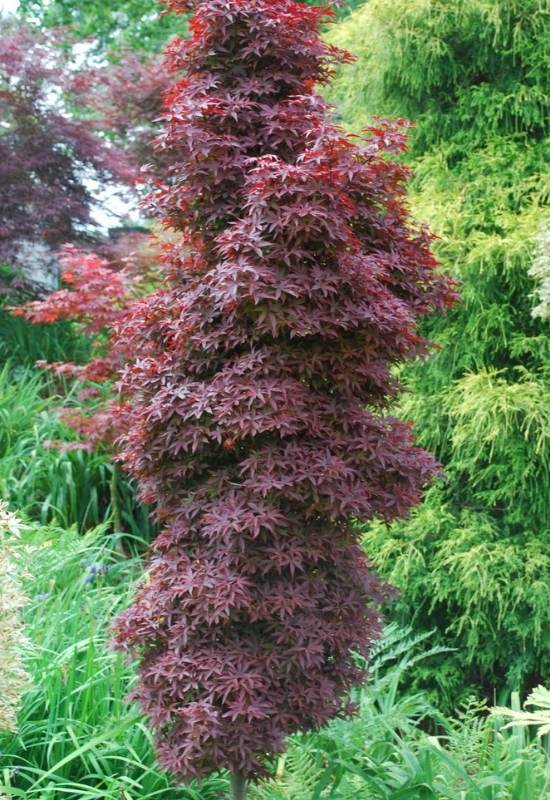
You would not expect a Japanese maple among tall and skinny trees, but the cultivar ‘Twombly’s Red Sentinel’ is quite original…
Unlike other maple trees, it does not have a spreading and open habit, but a columnar and dense one! But it retains the amazing foliage shape and color…
The palmate leaves have five points, with no serration, and they also have an extraordinary pigmentation… you will have a beautiful thick splash to wine to burgundy red purple in your garden with if you choose it.
And that’s all passers by or onlookers will be able to see from late spring to late fall…
You can use ‘Twombly’s Red Sentinel’ Japanese maple as a specimen plant to block views from neighbors, even to fill in gaps in fences etc.
But you can also mix it in with other trees and shrubs to form a dense hedge that keeps all eyes away from you, your garden your family and even your guests…
Whichever the function you choose for it, you will be making a statement about your gardening skills: that you can find an unusual, decorative, and creative solution to the problem of protecting privacy in green spaces.
Tall And Slim Trees For Privacy And Beauty As Well
We have seen many evergreen and deciduous trees that are tall and skinny and good for privacy. But let’s be honest… there is more to them than this practical function: they are all very beautiful too!

Written By
Margie Fetchik
Margie and Arkansas native has an extensive background in gardening and landscaping. For the last 40 years, Margie has called the Colorado Rocky Mountains her home. Here she and her husband of 36 years raised three kids and owned a successful landscaping company. Margie has a CSU Master Gardener certification. She specialized in garden design & installation, perennial gardens, turf grasses & weeds, flower containers, and the overall maintenance of allHOA, commercial and residential accounts. She and her husband now reside in Denver and are excited about the new experiences’ city life holds.
